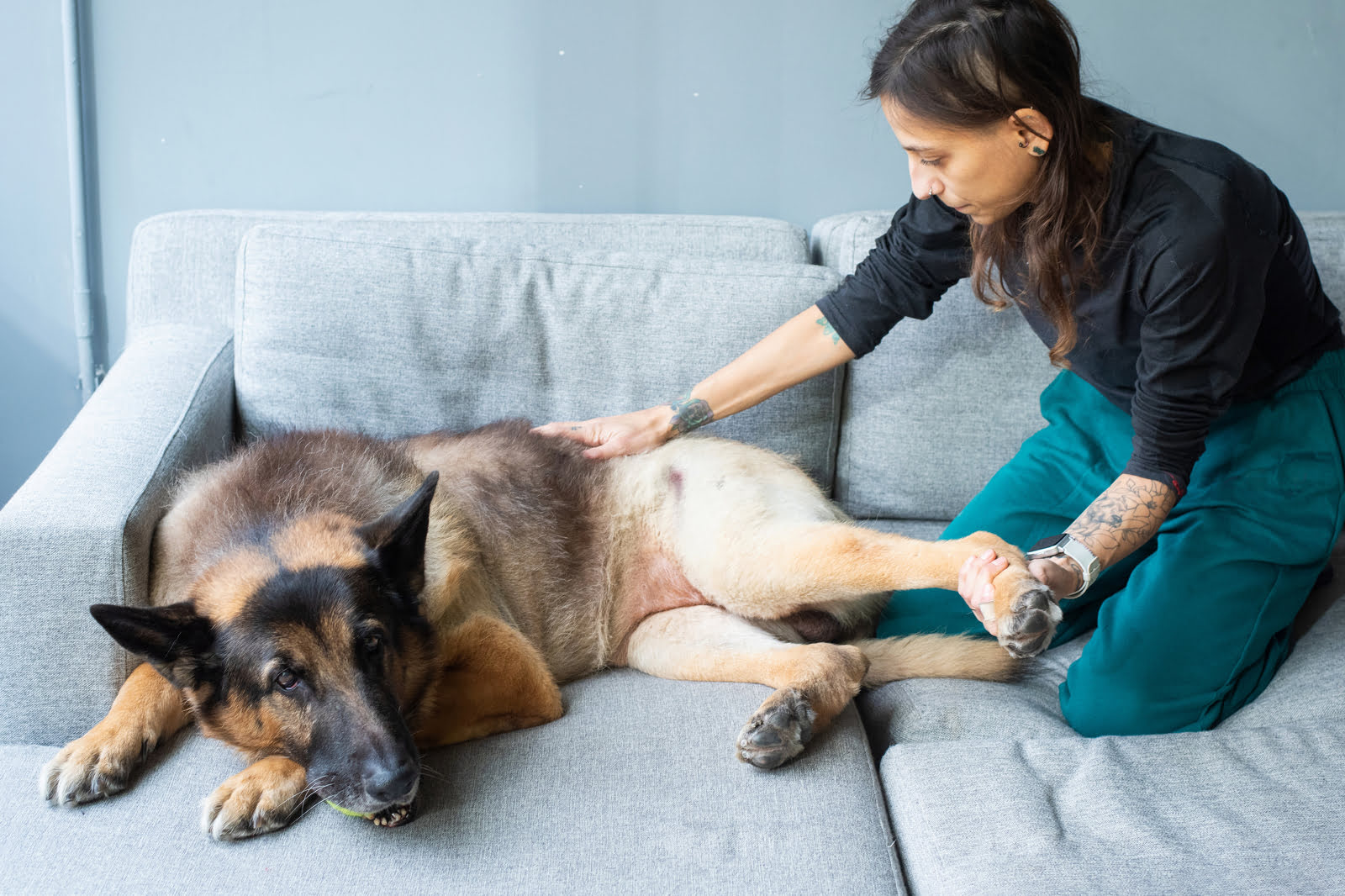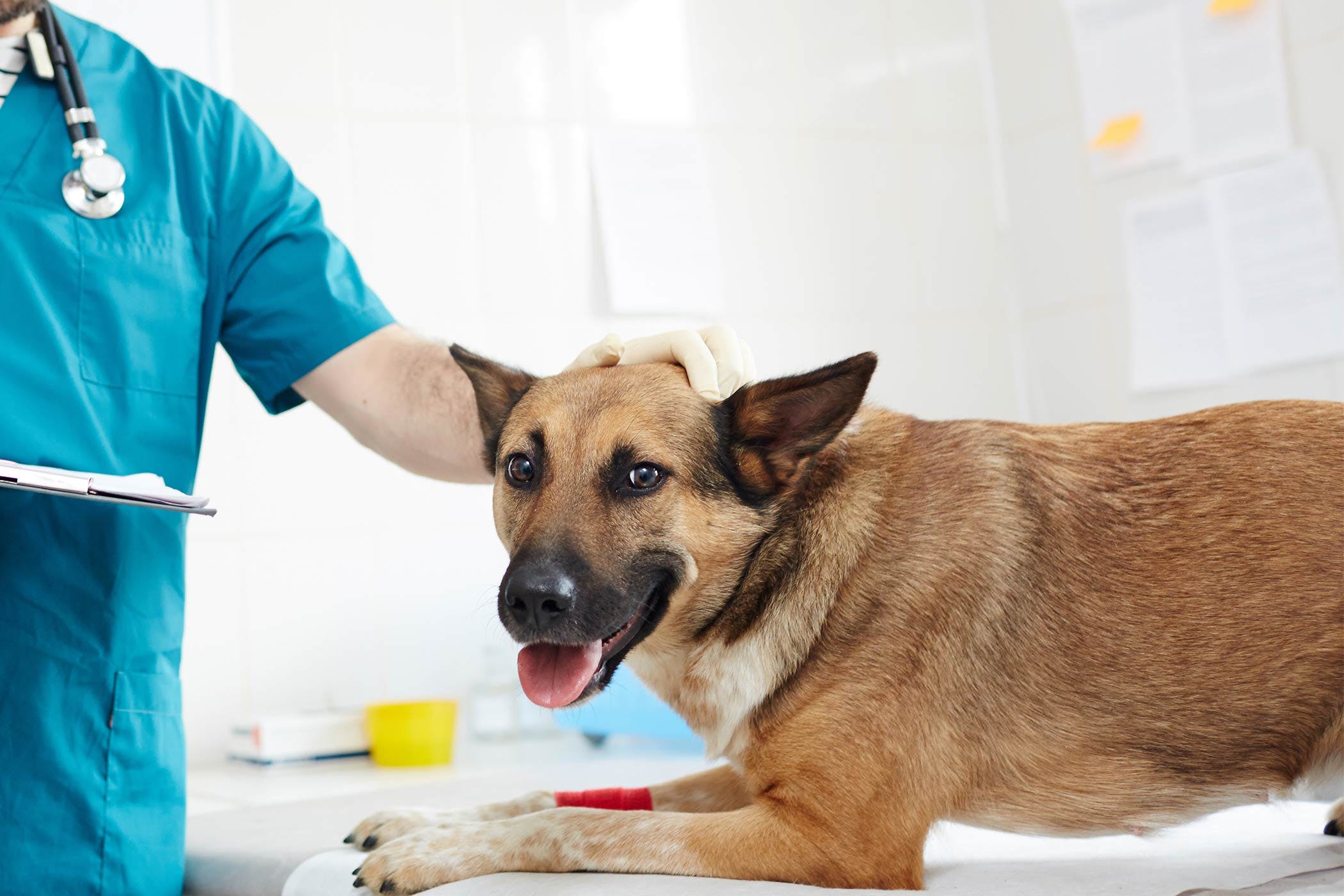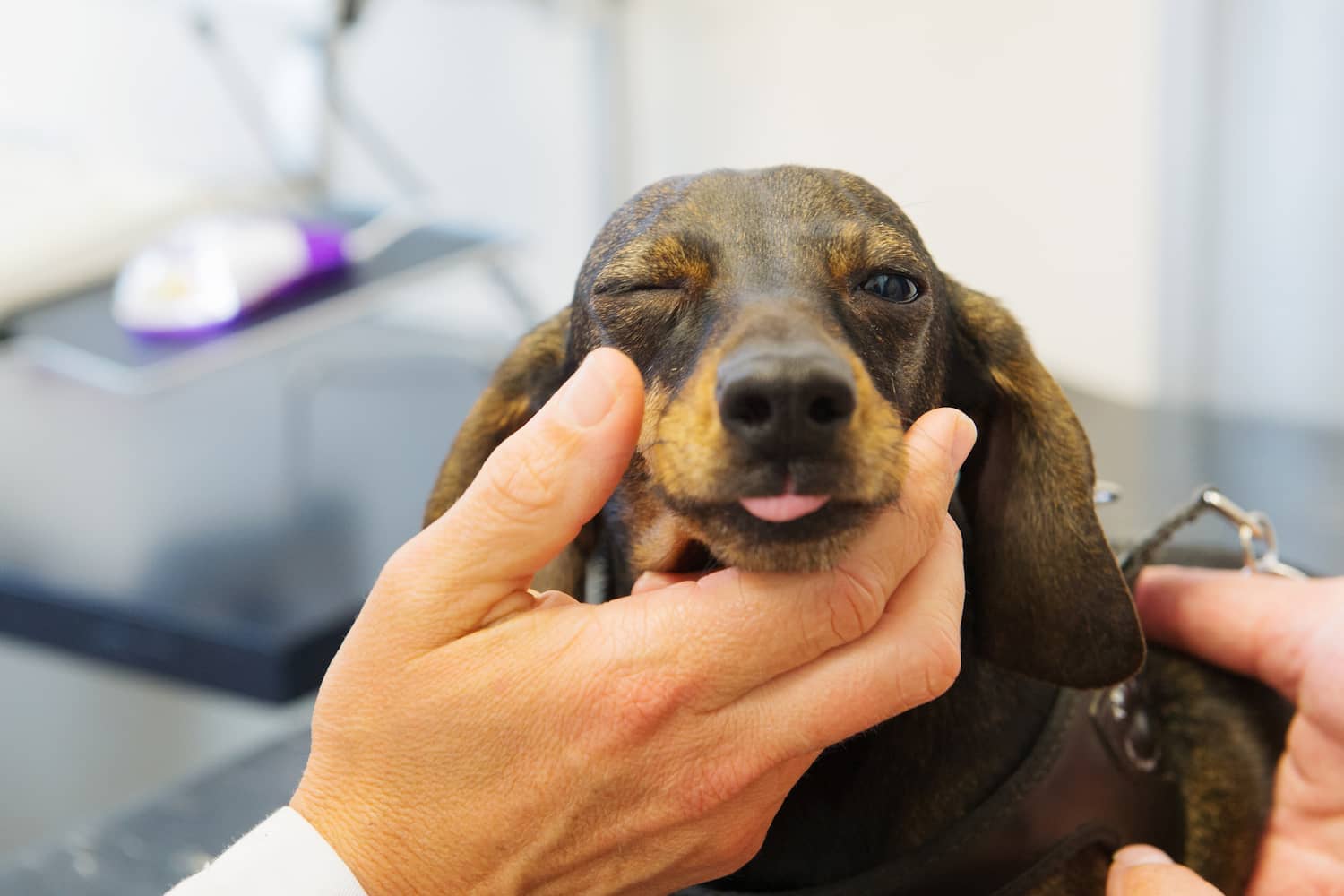Home>Health & Wellness>Common Health Issues>Muscular and Joint Health>How Do I Know If My Dog Has Arthritis Or Hip Dysplasia


Muscular and Joint Health
How Do I Know If My Dog Has Arthritis Or Hip Dysplasia
Modified: February 21, 2024
Learn how to recognize the signs of arthritis and hip dysplasia in your dog. Discover tips for maintaining their muscular and joint health.
(Many of the links in this article redirect to a specific reviewed product. Your purchase of these products through affiliate links helps to generate commission for Pawsomeoldies.com, at no extra cost. Learn more)
Table of Contents
Introduction
As a pet owner, ensuring the well-being of your furry companion is a top priority. Dogs, like humans, can experience musculoskeletal issues that impact their mobility and overall quality of life. Two common conditions that affect dogs' musculoskeletal health are arthritis and hip dysplasia. These conditions can cause discomfort, reduced mobility, and a decline in the dog's overall happiness. Understanding the signs, symptoms, and treatment options for arthritis and hip dysplasia is crucial for providing the best care for your canine friend.
Arthritis is a degenerative joint disease that can affect dogs of all ages, although it is more commonly seen in older dogs. It occurs when the cartilage within the joints deteriorates, leading to inflammation, pain, and stiffness. On the other hand, hip dysplasia is a genetic condition that primarily affects larger dog breeds. It occurs when the hip joint develops abnormally, leading to instability, pain, and eventually arthritis in the affected joint.
Recognizing the early signs of these conditions is essential for prompt intervention and management. By understanding the symptoms and seeking timely veterinary care, pet owners can help alleviate their dog's discomfort and improve their quality of life. Additionally, implementing preventive measures can help reduce the risk of these conditions developing in the first place.
In this comprehensive guide, we will delve into the intricacies of arthritis and hip dysplasia in dogs, exploring their symptoms, diagnosis, treatment options, and preventive measures. By gaining a deeper understanding of these conditions, you can become better equipped to support your canine companion's musculoskeletal health and well-being. Let's embark on this journey to empower ourselves with the knowledge needed to ensure our furry friends lead happy, active, and pain-free lives.
Understanding Arthritis in Dogs
Arthritis, a common musculoskeletal condition in dogs, is characterized by the inflammation and degeneration of the joints. This condition can affect dogs of all breeds and ages, although it is more prevalent in older dogs. The most common type of arthritis in dogs is osteoarthritis, which is also known as degenerative joint disease. Osteoarthritis occurs when the protective cartilage within the joints wears down over time, leading to pain, stiffness, and reduced mobility.
The primary cause of arthritis in dogs is the natural wear and tear of the joints as they age. However, other factors such as genetics, obesity, joint injuries, and developmental abnormalities can also contribute to the development of arthritis. Large breed dogs are particularly susceptible to arthritis due to their size and weight, which places increased stress on their joints.
The onset of arthritis in dogs can be gradual, making it challenging for pet owners to recognize the early signs. Common symptoms of arthritis in dogs include limping, reluctance to engage in physical activities, stiffness, difficulty rising from a lying position, and behavioral changes such as irritability or withdrawal. Additionally, dogs with arthritis may exhibit signs of pain when their affected joints are touched or manipulated.
Understanding the underlying causes and symptoms of arthritis in dogs is crucial for early intervention and management. By recognizing the signs of arthritis and seeking veterinary care, pet owners can explore treatment options to alleviate their dog's discomfort and improve their quality of life. Additionally, implementing lifestyle modifications and preventive measures can help manage the progression of arthritis and enhance the overall musculoskeletal health of dogs.
In the next sections, we will delve deeper into the symptoms, diagnosis, treatment options, and preventive measures for arthritis in dogs, providing valuable insights to support pet owners in caring for their canine companions.
Understanding Hip Dysplasia in Dogs
Hip dysplasia is a prevalent musculoskeletal condition that affects dogs, particularly larger breeds, and is characterized by an abnormal formation of the hip joint. This condition can lead to joint instability, pain, and eventually, the development of secondary osteoarthritis. Hip dysplasia is considered a genetic condition, and while it primarily manifests in younger dogs, its impact can be felt throughout the dog's life.
The hip joint is a ball-and-socket joint, where the femoral head (the ball) should fit snugly into the acetabulum (the socket). In dogs with hip dysplasia, this congruence is disrupted, leading to joint laxity and abnormal wear and tear. Over time, this can result in inflammation, pain, and reduced mobility, significantly impacting the dog's overall well-being.
The exact cause of hip dysplasia is multifactorial, involving genetic predisposition, environmental factors, and developmental influences. Factors such as rapid growth, excessive weight, and improper nutrition during the dog's early stages of life can contribute to the development and progression of hip dysplasia. Additionally, certain breeds are genetically predisposed to this condition, including German Shepherds, Labrador Retrievers, and Golden Retrievers.
Recognizing the symptoms of hip dysplasia in dogs is crucial for early intervention and management. Common signs of hip dysplasia include difficulty rising from a sitting or lying position, reluctance to engage in physical activities such as running or jumping, bunny hopping gait (where both hind legs move together), and noticeable discomfort or pain when the hips are manipulated. As the condition progresses, affected dogs may exhibit muscle atrophy in the hind legs and a decreased range of motion in the hip joint.
Diagnosing hip dysplasia typically involves a combination of physical examinations, radiographic imaging, and possibly advanced imaging techniques such as hip arthroscopy. Early detection of hip dysplasia allows for proactive measures to be taken to manage the condition and improve the dog's quality of life.
In the subsequent sections, we will explore the symptoms, diagnosis, treatment options, and preventive measures for hip dysplasia in dogs, providing valuable insights to support pet owners in understanding and addressing this challenging musculoskeletal condition.
Symptoms of Arthritis in Dogs
Recognizing the symptoms of arthritis in dogs is crucial for early intervention and management. While dogs are adept at masking signs of discomfort, pet owners can observe subtle changes in their pet's behavior and mobility that may indicate the presence of arthritis. Common symptoms of arthritis in dogs include:
-
Limping: Dogs with arthritis may exhibit a noticeable limp, especially after resting or engaging in physical activity. The limp may be more pronounced in the morning or after periods of inactivity.
-
Reluctance to Engage in Physical Activities: Dogs with arthritis may show reluctance to participate in activities they once enjoyed, such as playing fetch, going for walks, or climbing stairs. They may also exhibit decreased interest in engaging with other pets or family members.
-
Stiffness: Arthritic dogs may display stiffness, particularly after getting up from a lying position or after prolonged periods of rest. They may take longer to rise and may appear hesitant or slow when moving.
-
Difficulty Rising from a Lying Position: Dogs with arthritis may struggle to rise from a lying position, often exhibiting discomfort or stiffness in their joints as they attempt to stand.
-
Behavioral Changes: Arthritic dogs may display changes in behavior, such as increased irritability, restlessness, or withdrawal. They may seek solitude or exhibit signs of discomfort when approached or touched.
-
Pain Response: When affected joints are touched or manipulated, arthritic dogs may exhibit signs of pain, such as flinching, whimpering, or withdrawing the affected limb.
-
Muscle Atrophy: In advanced cases of arthritis, dogs may experience muscle atrophy in the affected limbs, leading to a noticeable decrease in muscle mass and strength.
Recognizing these symptoms can prompt pet owners to seek veterinary care for their furry companions. Early intervention and management of arthritis can significantly improve the dog's quality of life and alleviate discomfort. By understanding and identifying these symptoms, pet owners can provide the necessary support and care to ensure their canine companions lead active, pain-free lives.
In the subsequent sections, we will delve into the diagnosis, treatment options, and preventive measures for arthritis in dogs, providing valuable insights to empower pet owners in caring for their beloved pets.
Symptoms of Hip Dysplasia in Dogs
Recognizing the symptoms of hip dysplasia in dogs is essential for early detection and intervention. While this condition primarily affects larger dog breeds, its impact can be profound, leading to discomfort, reduced mobility, and a decline in the dog's overall well-being. Understanding the signs of hip dysplasia empowers pet owners to seek timely veterinary care and explore treatment options to improve their canine companion's quality of life.
Common symptoms of hip dysplasia in dogs include:
-
Difficulty Rising from a Sitting or Lying Position: Dogs with hip dysplasia may struggle to stand up from a sitting or lying position, often exhibiting signs of discomfort or stiffness in their hind legs. This difficulty in mobility can be particularly noticeable after periods of rest or inactivity.
-
Reluctance to Engage in Physical Activities: Affected dogs may show reluctance to participate in physical activities such as running, jumping, or climbing stairs. They may exhibit a decreased interest in engaging in play or exercise, indicating discomfort or pain associated with their hip joints.
-
Bunny Hopping Gait: Dogs with hip dysplasia may display a distinctive gait where both hind legs move together, resembling a hopping motion. This abnormal movement pattern is a result of the discomfort and instability caused by the condition.
-
Noticeable Discomfort or Pain: When the hips are manipulated or touched, dogs with hip dysplasia may exhibit signs of discomfort or pain. This can manifest as vocalization, flinching, or withdrawal of the affected limb, indicating sensitivity and discomfort in the hip joints.
-
Muscle Atrophy in Hind Legs: In advanced stages of hip dysplasia, affected dogs may experience muscle atrophy in their hind legs. This results in a visible decrease in muscle mass and strength, further impacting their mobility and overall physical condition.
-
Decreased Range of Motion in the Hip Joint: Dogs with hip dysplasia may exhibit a reduced range of motion in their hip joints, leading to stiffness and difficulty in performing regular movements such as walking, running, or standing up.
Recognizing these symptoms is crucial for initiating the diagnostic process and formulating an appropriate treatment plan. Early detection of hip dysplasia allows for proactive measures to be taken to manage the condition and improve the dog's quality of life. By understanding and identifying these symptoms, pet owners can provide the necessary support and care to ensure their canine companions lead active, pain-free lives.
Diagnosing Arthritis and Hip Dysplasia in Dogs
Diagnosing arthritis and hip dysplasia in dogs requires a comprehensive approach that encompasses physical examinations, imaging studies, and, in some cases, advanced diagnostic procedures. Veterinarians rely on a combination of clinical observations and diagnostic tests to accurately assess the musculoskeletal health of dogs and identify the presence of these conditions.
Diagnosing Arthritis:
When evaluating a dog for arthritis, veterinarians begin by conducting a thorough physical examination to assess the dog's gait, joint mobility, and overall musculoskeletal condition. They observe the dog's movement patterns, looking for signs of stiffness, discomfort, and limitations in joint range of motion. Additionally, veterinarians may palpate the dog's joints to identify areas of tenderness, swelling, or warmth, which are indicative of joint inflammation.
In cases where arthritis is suspected, diagnostic imaging studies such as X-rays (radiography) are commonly employed to visualize the affected joints. X-rays allow veterinarians to assess the joint structure, identify changes in bone density, and detect the presence of joint abnormalities such as bone spurs or joint space narrowing. These findings contribute to the confirmation of arthritis and aid in determining the extent of joint degeneration.
In some instances, veterinarians may recommend advanced imaging techniques such as joint aspiration or magnetic resonance imaging (MRI) to obtain a more detailed assessment of the affected joints. Joint aspiration involves the extraction of synovial fluid from the joint for analysis, providing insights into the presence of inflammation and potential joint infection. MRI, on the other hand, offers a comprehensive view of the joint structures, including soft tissues and cartilage, facilitating a more precise diagnosis of arthritis.
Diagnosing Hip Dysplasia:
The diagnosis of hip dysplasia in dogs involves a combination of physical examinations and radiographic imaging. Veterinarians assess the dog's gait, hind limb mobility, and overall hip joint stability during the physical examination. They look for signs of discomfort, abnormal movement patterns, and limitations in hip joint range of motion, which are indicative of hip dysplasia.
Radiographic imaging, particularly hip X-rays, plays a pivotal role in diagnosing hip dysplasia. These X-rays allow veterinarians to evaluate the hip joint conformation, assess the degree of joint laxity, and identify any degenerative changes within the joint. The presence of hip joint subluxation, abnormal femoral head and acetabulum congruence, and signs of secondary osteoarthritis on the X-rays contribute to the confirmation of hip dysplasia.
In complex cases or when additional information is required, veterinarians may recommend advanced imaging modalities such as computed tomography (CT) scans or hip arthroscopy. CT scans provide detailed cross-sectional images of the hip joint, offering insights into the structural abnormalities and the extent of joint degeneration. Hip arthroscopy, a minimally invasive procedure, allows for direct visualization of the hip joint's internal structures, facilitating a precise diagnosis and guiding potential treatment interventions.
By employing a combination of clinical assessments and diagnostic imaging, veterinarians can accurately diagnose arthritis and hip dysplasia in dogs, enabling pet owners to initiate appropriate treatment plans and supportive care for their canine companions. Early diagnosis is paramount in managing these musculoskeletal conditions and improving the overall well-being of affected dogs.
Treatment Options for Arthritis and Hip Dysplasia in Dogs
The treatment of arthritis and hip dysplasia in dogs focuses on alleviating discomfort, improving joint function, and enhancing the overall quality of life for affected pets. A multifaceted approach that combines medical management, lifestyle modifications, and supportive care is often employed to address the unique needs of each dog and mitigate the impact of these musculoskeletal conditions.
Read more: What To Do For Dog’s Hip Arthritis
Medical Management:
Arthritis:
- Non-Steroidal Anti-Inflammatory Drugs (NSAIDs): These medications are commonly prescribed to reduce joint inflammation and alleviate pain in arthritic dogs. NSAIDs help improve mobility and enhance the dog's comfort, enabling them to engage in physical activities with reduced discomfort.
- Disease-Modifying Osteoarthritis Drugs (DMOADs): DMOADs, such as polysulfated glycosaminoglycans and pentosan polysulfate, aim to slow the progression of arthritis by preserving joint cartilage and reducing inflammation. These drugs offer long-term benefits by supporting joint health and function.
Hip Dysplasia:
- Pain Management: Dogs with hip dysplasia may receive pain medications to alleviate discomfort and improve their mobility. Non-steroidal anti-inflammatory drugs (NSAIDs) and other analgesic medications are prescribed to manage pain associated with hip dysplasia, enhancing the dog's overall well-being.
- Joint Supplements: Nutraceuticals such as glucosamine, chondroitin, and omega-3 fatty acids are commonly recommended to support joint health and reduce inflammation in dogs with hip dysplasia. These supplements contribute to the maintenance of joint function and may help mitigate the progression of the condition.
Lifestyle Modifications:
- Weight Management: Maintaining a healthy body weight is crucial for dogs with arthritis and hip dysplasia. Excess weight places additional strain on the joints, exacerbating discomfort and hindering mobility. A balanced diet and regular exercise tailored to the dog's specific needs can help manage weight and reduce joint stress.
- Low-Impact Exercise: Engaging in low-impact activities such as swimming, leash walking, and gentle stretching exercises can help maintain joint flexibility and muscle strength in arthritic and dysplastic dogs. These exercises promote joint mobility while minimizing stress on the affected joints.
Supportive Care:
- Orthopedic Beds: Providing orthopedic or memory foam beds for affected dogs offers joint support and alleviates pressure on arthritic or dysplastic joints. These specialized beds help improve the dog's comfort during rest and sleep, contributing to overall joint health.
- Physical Therapy: Veterinary-supervised physical therapy sessions, including massage, hydrotherapy, and controlled exercises, can aid in improving joint mobility, reducing stiffness, and enhancing muscle strength in dogs with arthritis and hip dysplasia.
By implementing a tailored treatment plan that encompasses medical management, lifestyle modifications, and supportive care, pet owners can effectively manage arthritis and hip dysplasia in dogs, promoting their musculoskeletal health and ensuring a fulfilling and active life for their beloved pets. Regular veterinary consultations and proactive management are essential in addressing the unique needs of dogs with these conditions, fostering their well-being and vitality.
Preventing Arthritis and Hip Dysplasia in Dogs
Preventing arthritis and hip dysplasia in dogs involves proactive measures aimed at promoting musculoskeletal health and minimizing the risk factors associated with these conditions. By implementing preventive strategies, pet owners can play a pivotal role in safeguarding their canine companions from the onset and progression of arthritis and hip dysplasia, ultimately enhancing their overall well-being and quality of life.
Read more: How Do You Know If Your Dog Has Anxiety
Preventing Arthritis:
-
Maintaining Healthy Weight: Obesity is a significant risk factor for arthritis in dogs, as excess weight places undue stress on the joints, contributing to wear and tear. By providing a balanced diet and regular exercise, pet owners can help their dogs maintain a healthy weight, reducing the strain on their joints and minimizing the risk of developing arthritis.
-
Regular Exercise: Engaging in regular, low-impact exercise tailored to the dog's age and breed can promote joint flexibility, muscle strength, and overall musculoskeletal health. Activities such as leash walking, swimming, and gentle play can help maintain joint mobility and reduce the likelihood of arthritis.
-
Joint Supplements: Incorporating joint-supporting supplements such as glucosamine, chondroitin, and omega-3 fatty acids into the dog's diet can aid in preserving joint health and reducing inflammation. These supplements support cartilage integrity and may help mitigate the onset of arthritis in susceptible dogs.
Preventing Hip Dysplasia:
-
Selective Breeding: Responsible breeding practices, including the selection of breeding stock with healthy hip conformation, can help reduce the prevalence of hip dysplasia in certain dog breeds. Screening for hip dysplasia and obtaining certification from organizations such as the Orthopedic Foundation for Animals (OFA) can contribute to the breeding of dogs with improved hip joint health.
-
Proper Nutrition: Providing a balanced diet rich in essential nutrients, particularly during the dog's growth phase, is crucial for promoting proper bone and joint development. Proper nutrition supports skeletal health and may help mitigate the risk of hip dysplasia in susceptible breeds.
-
Regular Veterinary Check-ups: Routine veterinary examinations, particularly during the dog's early life stages, allow for the early detection of musculoskeletal abnormalities and the implementation of preventive measures. Veterinarians can provide guidance on preventive strategies and monitor the dog's musculoskeletal health over time.
By incorporating these preventive measures into their dogs' care routines, pet owners can significantly reduce the risk of arthritis and hip dysplasia, fostering the long-term musculoskeletal health and vitality of their beloved pets. Proactive management and a focus on preventive strategies are essential in promoting a fulfilling and active life for dogs, free from the constraints of these challenging musculoskeletal conditions.
Conclusion
In conclusion, the musculoskeletal health of dogs, particularly concerning arthritis and hip dysplasia, is a critical aspect of their overall well-being. These conditions can significantly impact a dog's mobility, comfort, and quality of life, underscoring the importance of early recognition, proactive management, and preventive measures.
Arthritis, a degenerative joint disease, can affect dogs of all ages, with older dogs being particularly susceptible. The gradual deterioration of joint cartilage leads to inflammation, stiffness, and discomfort, necessitating timely intervention and supportive care. Similarly, hip dysplasia, characterized by abnormal hip joint formation, predominantly affects larger dog breeds and can lead to joint instability and secondary osteoarthritis. Understanding the symptoms and diagnostic processes for these conditions empowers pet owners to seek veterinary care and explore tailored treatment options for their canine companions.
The symptoms of arthritis and hip dysplasia, including limping, stiffness, and reluctance to engage in physical activities, serve as crucial indicators for prompt intervention. Through a combination of physical examinations and diagnostic imaging, veterinarians can accurately diagnose these conditions, enabling pet owners to initiate appropriate treatment plans and supportive care. Medical management, lifestyle modifications, and supportive measures, such as weight management, low-impact exercise, and joint supplements, play a pivotal role in alleviating discomfort and enhancing the overall well-being of affected dogs.
Furthermore, preventive strategies, including maintaining a healthy weight, regular exercise, and selective breeding practices, are instrumental in minimizing the risk factors associated with arthritis and hip dysplasia. By incorporating these preventive measures into their dogs' care routines, pet owners can significantly reduce the likelihood of these musculoskeletal conditions, promoting long-term musculoskeletal health and vitality.
In essence, by gaining a deeper understanding of arthritis and hip dysplasia, pet owners can become better equipped to support their canine companions' musculoskeletal health. Through proactive management, early intervention, and a focus on preventive strategies, dogs can lead active, pain-free lives, fostering a fulfilling and vibrant bond between pets and their devoted owners.












